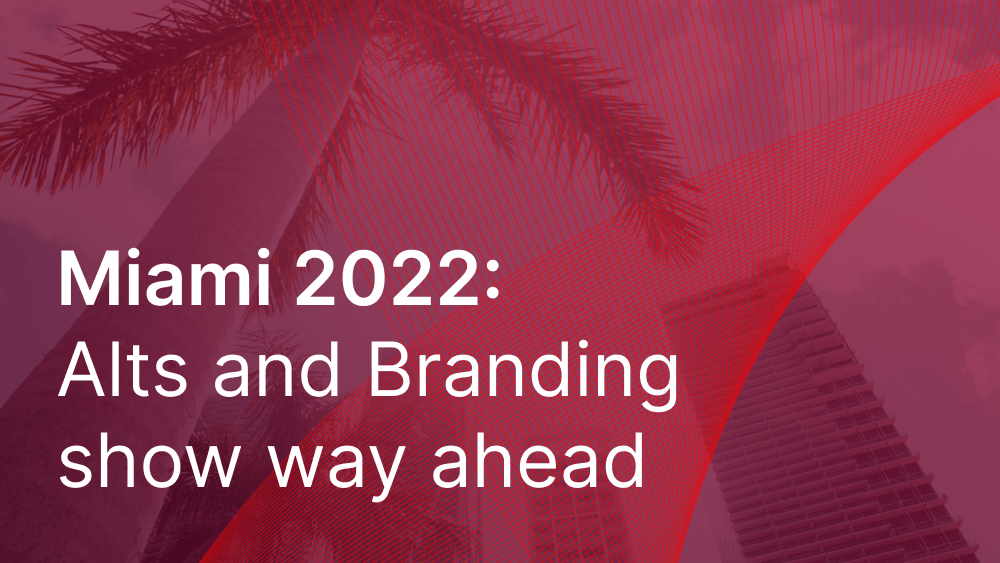Like many, I look forward to January and traveling to Miami to attend the always exciting week of top alternative investment conferences. Along with my fellow “Hedge Fund Week” attendees who traveled from dozens of countries, we shared a sense of relief to be breaking out of the virtual world for in-person networking.
The various events, including iConnections’ Global Alts, Agecroft’s Gaining the Edge, the Managed Funds Association’s Network 2022, and Context Summits all ran in close proximity to Miami. They offered us a first-hand look into what is driving investment management, both from the perspective of allocators such as pension funds, family offices, endowments and foundations, and RIAs; and from investment managers spanning hedge funds, private equity, venture capital, and crypto firms. Although 2021’s strong performance was still fresh in people’s minds, the early 2022 sell-off in markets had sparked uncertainty.
Given the backdrop of market volatility to the week’s discussions, it was instructive to note how both allocators and managers see a growing role for alternative investments over the coming year. Indeed, there was broad agreement around the increasing need for exposure to alternative investments to help hedge against the pitfalls of an aging bull market that is already showing the cracks of a cyclical turn. This need is especially acute given how the Federal Reserve has signaled that the era of cheap money is over and that we are in for multiple rate hikes this year.
Achieving more diversified portfolio
The secular rotation away from traditional asset managers to achieve more diversified portfolios was a key focus of a number of panels in Miami. The aim being to mitigate the risk of chasing market returns, and instead, provide unique and nuanced ways to preserve and enhance accumulated gains. This was made more urgent by the evolving risks of chasing 2021’s explosive economic growth in the current market, as it manages and prices in inflationary monetary policy.
The uncertainty associated with already frothy asset markets was especially pertinent to debt specialists, who seem to be in a unique position amid rising rates, widening spreads and continued high leverage. As we have seen, all these forces colliding together is fueling volatility and the need for alternative opportunities.
Besides the clear battle being waged between growth and value investing, the conferences often focused on niche strategies, such as specialty finance or crypto, as ways of effectively repositioning books. Increasing volatility is also heightening expectations for performance in both discretionary and systematic macro - the value of which has already been seen in returns through early February.
Also evident was the increasing embrace of ESG. This is leading to improved standardization of data, clearer understanding of the role of carbon offsets, and a heightened focus of asset management executives on moving further to embrace Diversity-Equity-Inclusion standards both in their investments and how their firms are managed.
Building brand awareness and relevancy
Another important priority, discussed by many GPs, concerned how to build brand awareness and relevancy. Central to this, in the views of many, is the need to enhance portfolio diversification through adding alternative investment capabilities. In turn, the acquisition of alternative managers is leading to the increased knowledge and popularity of these asset classes among investors. This is demonstrated in the growth of listed liquid alternative funds, whose assets soared in 2021 to record levels after enjoying their strongest flows in nearly a decade.
But more than expansion is needed to address the declining brand awareness many well-known investment houses are experiencing. This is not just a matter of name recognition - it also poses the essential question: “What are we now known for and by whom?”
"Before the global financial crisis, branding focused on performance and product. Today, it also includes pedigree, clarity of both process and purpose, in addition to top-quartile performance."
Before the global financial crisis, branding focused on performance and product. Today, it also includes pedigree, clarity of both process and purpose, in addition to top-quartile performance. Peregrine believe it is essential for a firm to deeply explore how it wants to be perceived and then wire that thinking into focused marketing strategies and campaigns. Those who do this convincingly will be tomorrow’s winners.
Given the significant transformation in the investment industry, managers more than ever must clearly offer and articulate competitive advantages. Increasingly, we believe, that means incorporating alternative strategies that offer a bridge to new areas of growth.
Cleary, such transitional moments are fraught with reputational risk - something which a number of panelists touched on. My takeaway is that it’s essential to set up and manage a clear and compelling narrative whether the issue at hand is an acquisition, a CEO departure or declining profitability and fee compression.
In this respect, Peregrine has found that doing leadership interviews and profiles offers considerable impact and is the most significant lever an asset manager can pull to build its brand. These profiles not only describe a firm’s edge, but also provide powerful messages that personalize a corporate story.
In our view, too few managers take advantage of this. We believe this is a mistake given the considerable evidence available that profiling of senior management and the C-Suite in key media is a highly effective way to raise brand awareness. Moreover, by focusing on the ‘people story’ that exists in every business, a firm can weave authenticity and a touch of personality into a story about business success.
Seeing so many allocators and investment firm gather in person in Miami served to remind me of the importance of having that personal touch.
By Max Hilton
February 2022


